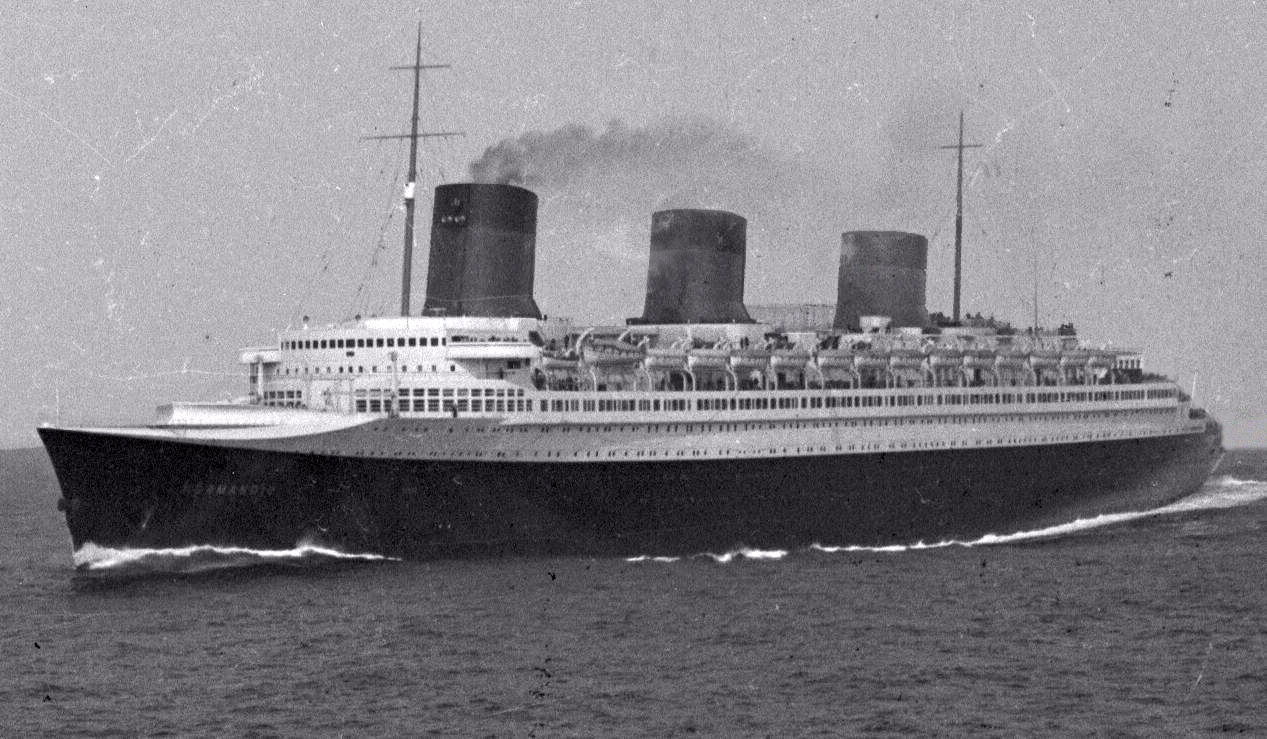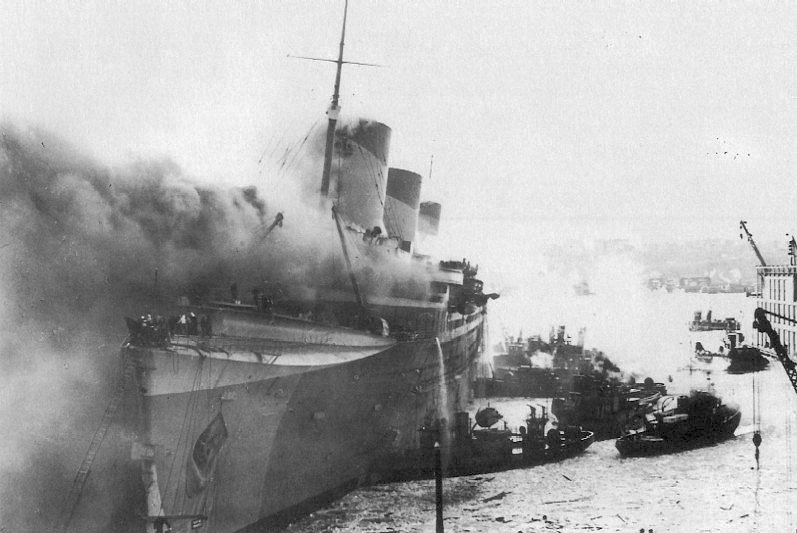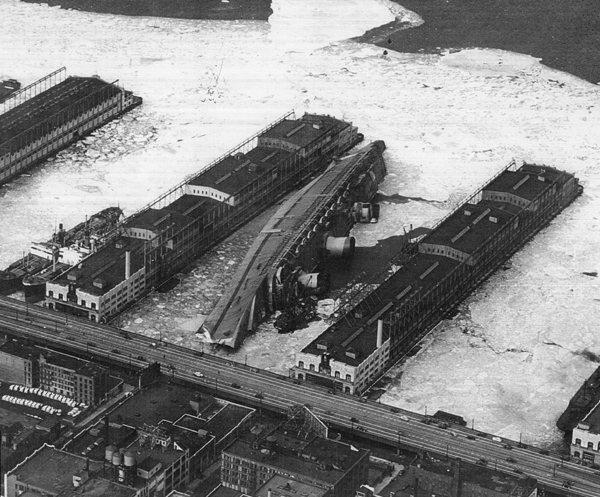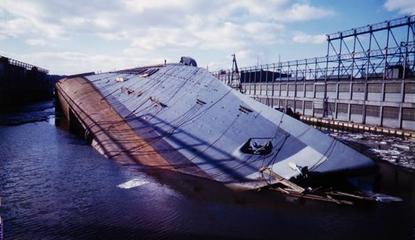Welcome to DU!
The truly grassroots left-of-center political community where regular people, not algorithms, drive the discussions and set the standards.
Join the community:
Create a free account
Support DU (and get rid of ads!):
Become a Star Member
Latest Breaking News
General Discussion
The DU Lounge
All Forums
Issue Forums
Culture Forums
Alliance Forums
Region Forums
Support Forums
Help & Search
General Discussion
Related: Editorials & Other Articles, Issue Forums, Alliance Forums, Region Forums76 years ago today; SS Normandie/USSLayfayette burns/capsizes @ Pier 88 NYC
https://en.wikipedia.org/wiki/SS_Normandie

The SS Normandie was an ocean liner built in Saint-Nazaire, France, for the French Line Compagnie Générale Transatlantique (CGT). She entered service in 1935 as the largest and fastest passenger ship afloat; she is still the most powerful steam turbo-electric-propelled passenger ship ever built.
Her novel design and lavish interiors led many to consider her the greatest of ocean liners.
Despite this, she was not a commercial success and relied partly on government subsidy to operate. During service as the flagship of the CGT, she made 139 westbound transatlantic crossings from her home port of Le Havre to New York. Normandie held the Blue Riband for the fastest transatlantic crossing at several points during her service career, during which the RMS Queen Mary was her main rival.
During World War II, Normandie was seized by U.S. authorities at New York and renamed USS Lafayette. In 1942, the liner caught fire while being converted to a troopship, capsized onto her port side and came to rest on the mud of the Hudson River at Pier 88, the site of the current New York Passenger Ship Terminal. Although salvaged at great expense, restoration was deemed too costly and she was scrapped in October 1946.
<snip>
https://en.wikipedia.org/wiki/SS_Normandie#World_War_II
World War II
The war found Normandie in New York harbor. Looming hostilities in Europe had compelled Normandie to seek haven there. The U.S. government interned her on 3 September 1939, two days after Germany invaded Poland. Soon the Queen Mary, later refitted as a troop ship, docked nearby. Then, 2 weeks later, RMS Queen Elizabeth joined the Queen Mary. For 5 months, the three largest liners in the world were tied up side by side. Normandie remained in French hands, with French crewmembers on board, led by Captain Hervé Lehuédé, into the spring of 1940.
On 15 May 1940, during the battle of France, the U.S. Treasury Department detailed about 150 Coast Guardsmen to go on board the ship and Pier 88 to defend it against possible sabotage. (Under then-current U.S. law, the U.S. Coast Guard was a part of the Treasury during peacetime.) When the U.S. Coast Guard (USCG) became a part of the Navy on 1 November 1941, Normandie's USCG detail remained intact, mainly observing while the French crew maintained the vessel's boilers, machinery, and other equipment, including the fire-watch system. On 12 December 1941, five days after the attack on Pearl Harbor, the Coast Guard removed Captain Lehuédé and his crew and took possession of the Normandie under the right of angary, maintaining steam in the boilers and other activities on the idled vessel. However, the elaborate fire-watch system which ensured that any fire would be suppressed before it became a danger was abandoned.
Lafayette conversion
On 20 December 1941, the Auxiliary Vessels Board officially recorded President Franklin D. Roosevelt's approval of Normandie's transfer to the U.S. Navy. Plans called for the vessel to be turned into a troopship ("convoy unit loaded transport" ). The Navy renamed her USS Lafayette, in honor both of Marquis de la Fayette, the French general who fought on the Colonies' behalf in the American Revolution, and the alliance with France that made American independence possible. The name was a suggestion of J.P. "Jim" Warburg, advisory assistant to Colonel William J. Donovan, Coordinator of Information, which was passed through multiple channels including the Secretary of the Navy Frank Knox, Admiral Harold R. Stark, Chief of Naval Operations (CNO), and Rear Adm. Randall Jacobs, Chief of the Bureau of Navigation; the name La Fayette (later universally and unofficially contracted to Lafayette) was officially approved by the Secretary of the Navy on 31 December 1941, with the vessel classified as a transport, AP-53.
Earlier proposals included turning the vessel into an aircraft carrier, but this was dropped in favor of immediate troop transport. The ship remained moored at Manhattan's Pier 88 for the conversion. A contract for her conversion to a troop transport was awarded to Robins Dry Dock and Repair Co., a subsidiary of Todd Shipyards, on 27 December 1941. On that date, Capt. Clayton M. Simmers, the 3rd Naval District Materiel Officer, reported to the Bureau of Ships (BuShips) his estimate that the conversion work could be completed by 31 January 1942, and planning for the work proceeded on that basis.
Capt. Robert G. Coman reported as Lafayette's prospective commanding officer on 31 January 1942, overseeing a skeleton engineering force numbering 458 men. The complicated nature and enormous size of the conversion effort prevented Coman's crew from adhering to the original schedule; crew familiarization with the vessel was an issue, and additional crew members were arriving to assist the effort. On 6 February 1942, a request for a two-week delay for the first sailing of Lafayette, originally scheduled for 14 February, was submitted to the Assistant Chief of Naval Operations. On that day, a schedule extension was granted due to a design plan change: elements of the superstructure were to be removed to improve stability, in work that was expected to take another 60 to 90 days. However, on 7 February, orders came from Washington that the reduction of the top-hamper had been abandoned and Lafayette was to sail on 14 February as planned. This abrupt reversal necessitated a frantic resumption of conversion work, and Capts Coman and Simmers scheduled 9 February[clarification needed] meetings in New York and Washington to lobby for further clarification of conversion plans; ultimately, these meetings would never take place.
Fire and capsizing

At 14:30 on 9 February 1942, sparks from a welding torch used by Clement Derrick ignited a stack of life vests filled with flammable kapok that had been stored in the first-class lounge. The woodwork had not yet been removed, and the fire spread rapidly. The ship had a very efficient fire protection system, but it had been disconnected during the conversion and its internal pumping system was deactivated. The New York City fire department's hoses, unfortunately, did not fit the ship's French inlets. Before the fire department arrived, approximately 15 minutes after fire broke out, all onboard crew were using manual means in a vain attempt to stop the blaze. A strong northwesterly wind blowing over Lafayette's port quarter swept the blaze forward, eventually involving the three upper decks of the ship within an hour of the start of the conflagration. Capt. Coman, along with Capt. Simmers, arrived about 15:25 to see his huge prospective command in flames.
As firefighters on shore and in fire boats poured water on the blaze, the ship developed a dangerous list to port due to water pumped into the seaward side by fireboats. The ship's designer Vladimir Yourkevitch arrived at the scene to offer expertise, but he was barred by harbor police.[48][59] His suggestion was to enter the vessel and open the sea-cocks. This would flood the lower decks and make her settle the few feet to the bottom. With the ship stabilised, water could be pumped into burning areas without the risk of capsize. The suggestion was rejected by the commander of the 3rd Naval District, Rear Admiral Adolphus Andrews.
Between 17:45 and 18:00 on 9 February 1942, authorities considered the fire under control, and began winding down operations until 20:00. Water entering the ship through submerged openings and flowing to the lower decks negated efforts to counter-flood, and Lafayette's list gradually increased to port. Shortly after midnight, Rear Adm. Andrews ordered Lafayette abandoned, and the ship continued to list, a process hastened by the 6,000 tons of water that had been played on her. New York fire officials were concerned that the fire could spread to the nearby city buildings. Lafayette eventually capsized during the mid watch (02:45) on 10 February, nearly crushing a fire boat, and came to rest on her port side at an angle of approximately 80 degrees. Recognising that his incompetence had caused the disaster, Admiral Andrews ordered all pressmen barred from viewing the moment of capsize in an effort to lower the level of publicity.

One man died in the tragedy — Frank "Trent" Trentacosta, 36, of Brooklyn, a Robins' employee and a member of the fire watch. Some 94 USCG and USN sailors, including some from Lafayette's pre-commissioning crew and men assigned to the receiving ship Seattle, 38 fire fighters, and 153 civilians were treated for various injuries, burns, smoke inhalation, and exposure.

<snip>

The SS Normandie was an ocean liner built in Saint-Nazaire, France, for the French Line Compagnie Générale Transatlantique (CGT). She entered service in 1935 as the largest and fastest passenger ship afloat; she is still the most powerful steam turbo-electric-propelled passenger ship ever built.
Her novel design and lavish interiors led many to consider her the greatest of ocean liners.
Despite this, she was not a commercial success and relied partly on government subsidy to operate. During service as the flagship of the CGT, she made 139 westbound transatlantic crossings from her home port of Le Havre to New York. Normandie held the Blue Riband for the fastest transatlantic crossing at several points during her service career, during which the RMS Queen Mary was her main rival.
During World War II, Normandie was seized by U.S. authorities at New York and renamed USS Lafayette. In 1942, the liner caught fire while being converted to a troopship, capsized onto her port side and came to rest on the mud of the Hudson River at Pier 88, the site of the current New York Passenger Ship Terminal. Although salvaged at great expense, restoration was deemed too costly and she was scrapped in October 1946.
<snip>
https://en.wikipedia.org/wiki/SS_Normandie#World_War_II
World War II
The war found Normandie in New York harbor. Looming hostilities in Europe had compelled Normandie to seek haven there. The U.S. government interned her on 3 September 1939, two days after Germany invaded Poland. Soon the Queen Mary, later refitted as a troop ship, docked nearby. Then, 2 weeks later, RMS Queen Elizabeth joined the Queen Mary. For 5 months, the three largest liners in the world were tied up side by side. Normandie remained in French hands, with French crewmembers on board, led by Captain Hervé Lehuédé, into the spring of 1940.
On 15 May 1940, during the battle of France, the U.S. Treasury Department detailed about 150 Coast Guardsmen to go on board the ship and Pier 88 to defend it against possible sabotage. (Under then-current U.S. law, the U.S. Coast Guard was a part of the Treasury during peacetime.) When the U.S. Coast Guard (USCG) became a part of the Navy on 1 November 1941, Normandie's USCG detail remained intact, mainly observing while the French crew maintained the vessel's boilers, machinery, and other equipment, including the fire-watch system. On 12 December 1941, five days after the attack on Pearl Harbor, the Coast Guard removed Captain Lehuédé and his crew and took possession of the Normandie under the right of angary, maintaining steam in the boilers and other activities on the idled vessel. However, the elaborate fire-watch system which ensured that any fire would be suppressed before it became a danger was abandoned.
Lafayette conversion
On 20 December 1941, the Auxiliary Vessels Board officially recorded President Franklin D. Roosevelt's approval of Normandie's transfer to the U.S. Navy. Plans called for the vessel to be turned into a troopship ("convoy unit loaded transport" ). The Navy renamed her USS Lafayette, in honor both of Marquis de la Fayette, the French general who fought on the Colonies' behalf in the American Revolution, and the alliance with France that made American independence possible. The name was a suggestion of J.P. "Jim" Warburg, advisory assistant to Colonel William J. Donovan, Coordinator of Information, which was passed through multiple channels including the Secretary of the Navy Frank Knox, Admiral Harold R. Stark, Chief of Naval Operations (CNO), and Rear Adm. Randall Jacobs, Chief of the Bureau of Navigation; the name La Fayette (later universally and unofficially contracted to Lafayette) was officially approved by the Secretary of the Navy on 31 December 1941, with the vessel classified as a transport, AP-53.
Earlier proposals included turning the vessel into an aircraft carrier, but this was dropped in favor of immediate troop transport. The ship remained moored at Manhattan's Pier 88 for the conversion. A contract for her conversion to a troop transport was awarded to Robins Dry Dock and Repair Co., a subsidiary of Todd Shipyards, on 27 December 1941. On that date, Capt. Clayton M. Simmers, the 3rd Naval District Materiel Officer, reported to the Bureau of Ships (BuShips) his estimate that the conversion work could be completed by 31 January 1942, and planning for the work proceeded on that basis.
Capt. Robert G. Coman reported as Lafayette's prospective commanding officer on 31 January 1942, overseeing a skeleton engineering force numbering 458 men. The complicated nature and enormous size of the conversion effort prevented Coman's crew from adhering to the original schedule; crew familiarization with the vessel was an issue, and additional crew members were arriving to assist the effort. On 6 February 1942, a request for a two-week delay for the first sailing of Lafayette, originally scheduled for 14 February, was submitted to the Assistant Chief of Naval Operations. On that day, a schedule extension was granted due to a design plan change: elements of the superstructure were to be removed to improve stability, in work that was expected to take another 60 to 90 days. However, on 7 February, orders came from Washington that the reduction of the top-hamper had been abandoned and Lafayette was to sail on 14 February as planned. This abrupt reversal necessitated a frantic resumption of conversion work, and Capts Coman and Simmers scheduled 9 February[clarification needed] meetings in New York and Washington to lobby for further clarification of conversion plans; ultimately, these meetings would never take place.
Fire and capsizing

At 14:30 on 9 February 1942, sparks from a welding torch used by Clement Derrick ignited a stack of life vests filled with flammable kapok that had been stored in the first-class lounge. The woodwork had not yet been removed, and the fire spread rapidly. The ship had a very efficient fire protection system, but it had been disconnected during the conversion and its internal pumping system was deactivated. The New York City fire department's hoses, unfortunately, did not fit the ship's French inlets. Before the fire department arrived, approximately 15 minutes after fire broke out, all onboard crew were using manual means in a vain attempt to stop the blaze. A strong northwesterly wind blowing over Lafayette's port quarter swept the blaze forward, eventually involving the three upper decks of the ship within an hour of the start of the conflagration. Capt. Coman, along with Capt. Simmers, arrived about 15:25 to see his huge prospective command in flames.
As firefighters on shore and in fire boats poured water on the blaze, the ship developed a dangerous list to port due to water pumped into the seaward side by fireboats. The ship's designer Vladimir Yourkevitch arrived at the scene to offer expertise, but he was barred by harbor police.[48][59] His suggestion was to enter the vessel and open the sea-cocks. This would flood the lower decks and make her settle the few feet to the bottom. With the ship stabilised, water could be pumped into burning areas without the risk of capsize. The suggestion was rejected by the commander of the 3rd Naval District, Rear Admiral Adolphus Andrews.
Between 17:45 and 18:00 on 9 February 1942, authorities considered the fire under control, and began winding down operations until 20:00. Water entering the ship through submerged openings and flowing to the lower decks negated efforts to counter-flood, and Lafayette's list gradually increased to port. Shortly after midnight, Rear Adm. Andrews ordered Lafayette abandoned, and the ship continued to list, a process hastened by the 6,000 tons of water that had been played on her. New York fire officials were concerned that the fire could spread to the nearby city buildings. Lafayette eventually capsized during the mid watch (02:45) on 10 February, nearly crushing a fire boat, and came to rest on her port side at an angle of approximately 80 degrees. Recognising that his incompetence had caused the disaster, Admiral Andrews ordered all pressmen barred from viewing the moment of capsize in an effort to lower the level of publicity.

One man died in the tragedy — Frank "Trent" Trentacosta, 36, of Brooklyn, a Robins' employee and a member of the fire watch. Some 94 USCG and USN sailors, including some from Lafayette's pre-commissioning crew and men assigned to the receiving ship Seattle, 38 fire fighters, and 153 civilians were treated for various injuries, burns, smoke inhalation, and exposure.

<snip>
A stunning ship and engineering feat of her day.
InfoView thread info, including edit history
TrashPut this thread in your Trash Can (My DU » Trash Can)
BookmarkAdd this thread to your Bookmarks (My DU » Bookmarks)
2 replies, 1302 views
ShareGet links to this post and/or share on social media
AlertAlert this post for a rule violation
PowersThere are no powers you can use on this post
EditCannot edit other people's posts
ReplyReply to this post
EditCannot edit other people's posts
Rec (6)
ReplyReply to this post
2 replies
 = new reply since forum marked as read
Highlight:
NoneDon't highlight anything
5 newestHighlight 5 most recent replies
= new reply since forum marked as read
Highlight:
NoneDon't highlight anything
5 newestHighlight 5 most recent replies
76 years ago today; SS Normandie/USSLayfayette burns/capsizes @ Pier 88 NYC (Original Post)
Dennis Donovan
Feb 2018
OP
Very true. William Francis Gibbs was involved in the Normandie conversion
Dennis Donovan
Feb 2018
#2
hunter
(38,311 posts)1. This fire was one reason everything inside the SS United States was fireproof.
United States used no wood in the ship's framing, accessories, decorations, or interior surfaces. Fittings, including all furniture and fabrics, were custom made in glass, metal, and spun glass fiber to ensure compliance with fireproofing guidelines set by the US Navy. Asbestos-laden paneling were used extensively in interior structures. Specially commissioned artwork included pieces by fourteen artists, including Nathaniel Choate, muralist Austin M. Purves, Jr., and sculptor Gwen Lux. Although the galley did feature a butcher block, the clothes hangers in the luxury cabins were aluminum. The ballroom's grand piano was made from a rare, fire-resistant wood species—although originally specified in aluminum—and accepted only after a demonstration in which gasoline was poured upon the wood and ignited, without the wood itself ever catching fire.
https://en.wikipedia.org/wiki/SS_United_States
https://en.wikipedia.org/wiki/SS_United_States
Dennis Donovan
(18,770 posts)2. Very true. William Francis Gibbs was involved in the Normandie conversion
...and her loss (and overall design) was greatly influenced by SS Normandie.